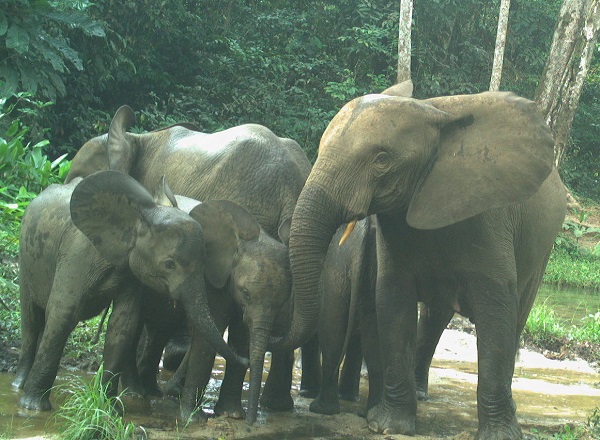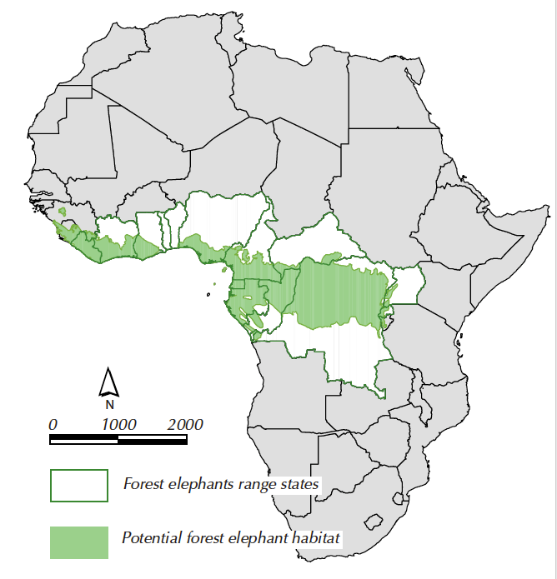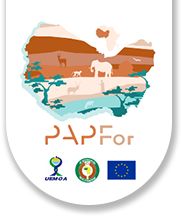Home / Guinean forests / Characteristics / The biodiversity / Species identity card / The forest elephant
The forest elephant
- Class : mammal
- Order : Proboscids
- Family : Elephantidae
- Genus : Loxodonta
- Specie: cyclotis
- Weight: from 2 to 6 tonnes
- Size: 1,5 to 3,5 m at the withers and4 to 7 m leong
- Diet : megaherbivore, consuming a large number of plants with a very varied diet (fruits, leaves, bark, herbaceous)
- Very social animal but evolves in small groups, which move over long distances and therefore need large territories to survive
- Lifespan : from 60 to 70 years
- Reproduction : The reproductive functions appear from the age of 9 in the female elephant. Male elephants reproduce around the age of 30. Gestation is the longest of any land mammal: 20 to 22 months. In most cases, only one elephant is carried. Females give birth to their first baby around 23 years old (unlike savannah elephants, which do so around 11-14 years old).

The African forest elephant (Loxodonta cyclotis) is the cousin of the African savanna elephant (Loxodonta africana) and the Asian elephant (Elephas maximus). It is smaller, especially with shorter and straighter tusks, than the savannah elephants, adapted to the forest environment where it is more difficult to move through the dense undergrowth. It is generally found in the dense forest of Central and West Africa, but is also sometimes on the edge of forest territory, just like the savannah elephant, with which it can breed and have viable and healthy offspring.
The forest elephant: an important ecological function
The African forest elephant contributes to maintaining the composition and structure of the Guinean forests of West Africa.
This species is truly dependent on the forest (and in particular on the fruits of forest trees) for food. As a megaherbivore, it consumes a large number of plants and fruits. The African forest elephant eats more than 200 kg of plants per day to sustain itself. It contributes to the regeneration of many species by dispersing swallowed seeds over significant distances.
Some plant and tree seeds only germinate after passing through an elephant’s digestive tract. In addition, elephant dung provides a nutrient-rich environment for the growth of seedlings and is a veritable restaurant for many insects, including butterflies, which come to collect mineral salts.
Also, by creating trails and openings in the forest canopy as they move through the forest, forest elephants create or maintain corridors used by other species and support slow growing trees (typically hardwood and shade-tolerant species). They also maintain forest clearings (called salinas or baïs) where they take advantage of the large amount of mineral salts available.
A critically endangered species
This species is less well known than the savannah elephant because of ecological and political barriers, which have made it more difficult to study and protect. It has disappeared from a large part of its natural range and, where it is still present, it is declining at an alarming rate, even though it plays a very important ecological role.
The forest elephant has no real predators apart from humans. Hunting and poaching, particularly for the trade in ivory from their tusks, are the main threats facing Guinean forest elephants.
Deforestation and fragmentation of the Guinean forests lead to a loss of habitat. The risk of conflict over habitat with human populations, also known as human-elephant conflict, increases and threatens the survival of the elephant. When the forest is reduced, elephants become part of the problem, as they rapidly destroy the vegetation in the area where they live and eliminate food resources.
On 25 March 2021, the forest elephant was classified as ’critically endangered’ by the International Union for Conservation of Nature. The organisation points out that its population fell by 86% between 1990 and 2021 (https://www.iucnredlist.org/species/181007989/181019888).
The Convention on the International Trade in Endangered Species of Wild Fauna and Flora (CITES) lists it in its Appendix 1 as an endangered species, prohibited from international trade. However, trade in the species may be allowed under exceptional conditions - for scientific research, for example. When this is the case, an export permit (or re-export certificate) and an import permit are issued. (https://cites.org/fra/app/appendices.php)
African elephants, both savannah and forest, are estimated to number only about 415 000 individuals (IUCN, 2016), down from about 10 million before the decline of the last two centuries. This represents a 95% loss of their population. There is little reliable data on elephant numbers in West Africa, but estimates show small and isolated populations of around 11 500.

MIKE (Monitoring the Illegal Killing of Elephants : https://cites.org/fra/prog/mike/index.php/portal)
The MIKE programme is entirely dependent on donor support. The European Union has been the largest donor to MIKE and has funded implementation in Africa since its inception in 2001, and in Asia since 2017. Funding has also been provided by the US Fish and Wildlife Service and the governments of Japan, the UK and China.
The overall objective of MIKE is to provide the information necessary for elephant range states and CITES to make appropriate management and enforcement decisions, and to build the institutional capacity of range states for the long-term management of their elephant populations. MIKE aims to help range States improve their capacity to monitor elephant populations, detect changes in levels of illegal killing, and use this information to ensure more effective enforcement and strengthen any regulatory measures needed to support that enforcement.
Recent observations in Liberia
For the northwestern forest block in Liberia, which represents a large proportion of the Upper Guinean forests, the ELRECO (Elephant Research and Conservation https://www.elreco.org/index_en.html) project recently estimated that the remaining forest elephant population numbers between 350 and 450 individuals, or even less.
These elephants are distributed throughout the Gola-Foya and Wologizi-Wonegizi-Ziama landscapes, both supported by the PAPFor programme. They migrate and are also found outside the protected areas. It is therefore crucial to maintain connectivity through forest corridors between all protected areas, which is one of the objectives of PAPFor.

